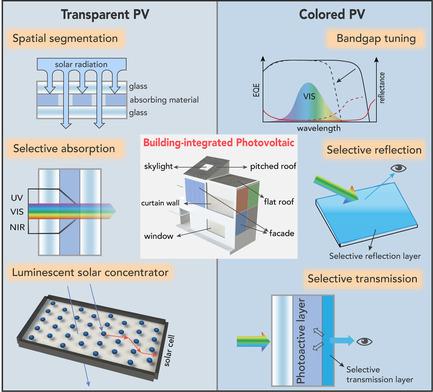Our official English website, www.x-mol.net, welcomes your feedback! (Note: you will need to create a separate account there.)
Transparent and Colored Solar Photovoltaics for Building Integration
Solar RRL ( IF 7.9 ) Pub Date : 2020-12-19 , DOI: 10.1002/solr.202000614 Zhenpeng Li 1 , Tao Ma 1 , Hongxing Yang 2 , Lin Lu 2 , Ruzhu Wang 1
Solar RRL ( IF 7.9 ) Pub Date : 2020-12-19 , DOI: 10.1002/solr.202000614 Zhenpeng Li 1 , Tao Ma 1 , Hongxing Yang 2 , Lin Lu 2 , Ruzhu Wang 1
Affiliation

|
Building‐integrated photovoltaics (BIPVs) stand as a promising solution to provide renewable electricity for achieving zero‐energy buildings, although still hindered from large‐scale implementations due to the difficulty of traditional photovoltaic modules in meeting the standards and aesthetics of architectural materials. The emergence of new photovoltaic materials and devices could pave the way for the future through offering diversity and tunability in colors and transparency along with comparable performance. Herein the recent advances in BIPVs are discussed, starting from an overview of various photovoltaic technologies regarding their material characteristics, state of the art, and adaptability to the built environment. The transparent and colored photovoltaic technologies are then respectively emphasized, concerning design principles, theoretical analysis, technical routes, and corresponding demonstration studies. The various strategies, including the materials and structures adopted to modify the transparency and color of solar cells, are highlighted. Finally, the challenges and future perspectives are addressed, followed by an outlook on factors that are critical for large‐scale implementation of BIPVs in the future.
中文翻译:

透明和彩色太阳能光伏建筑一体化
尽管由于传统光伏模块难以满足建筑材料的标准和美学要求,建筑集成光伏(BIPV)仍是一种有前途的解决方案,可为实现零能耗建筑物提供可再生电力,但仍受大规模实施的阻碍。通过提供颜色和透明度的多样性和可调谐性以及可比的性能,新的光伏材料和设备的出现可以为未来铺平道路。在此,从各种光伏技术的概述,其材料特性,技术水平以及对建筑环境的适应性的角度出发,讨论了BIPV的最新进展。然后,就设计原理,分别强调了透明和彩色光伏技术。理论分析,技术路线和相应的论证研究。重点介绍了各种策略,包括用来修改太阳能电池的透明度和颜色的材料和结构。最后,解决了挑战和未来观点,然后展望了对将来大规模实施BIPV至关重要的因素。
更新日期:2020-12-19
中文翻译:

透明和彩色太阳能光伏建筑一体化
尽管由于传统光伏模块难以满足建筑材料的标准和美学要求,建筑集成光伏(BIPV)仍是一种有前途的解决方案,可为实现零能耗建筑物提供可再生电力,但仍受大规模实施的阻碍。通过提供颜色和透明度的多样性和可调谐性以及可比的性能,新的光伏材料和设备的出现可以为未来铺平道路。在此,从各种光伏技术的概述,其材料特性,技术水平以及对建筑环境的适应性的角度出发,讨论了BIPV的最新进展。然后,就设计原理,分别强调了透明和彩色光伏技术。理论分析,技术路线和相应的论证研究。重点介绍了各种策略,包括用来修改太阳能电池的透明度和颜色的材料和结构。最后,解决了挑战和未来观点,然后展望了对将来大规模实施BIPV至关重要的因素。

























 京公网安备 11010802027423号
京公网安备 11010802027423号